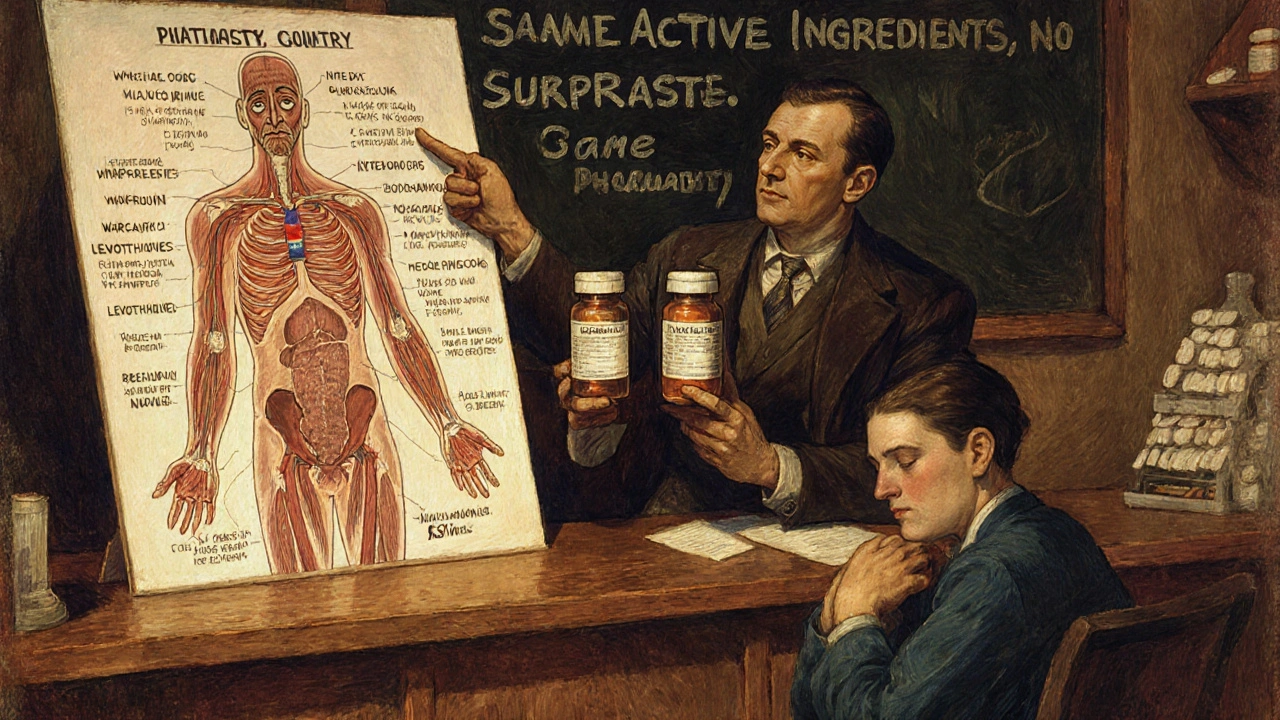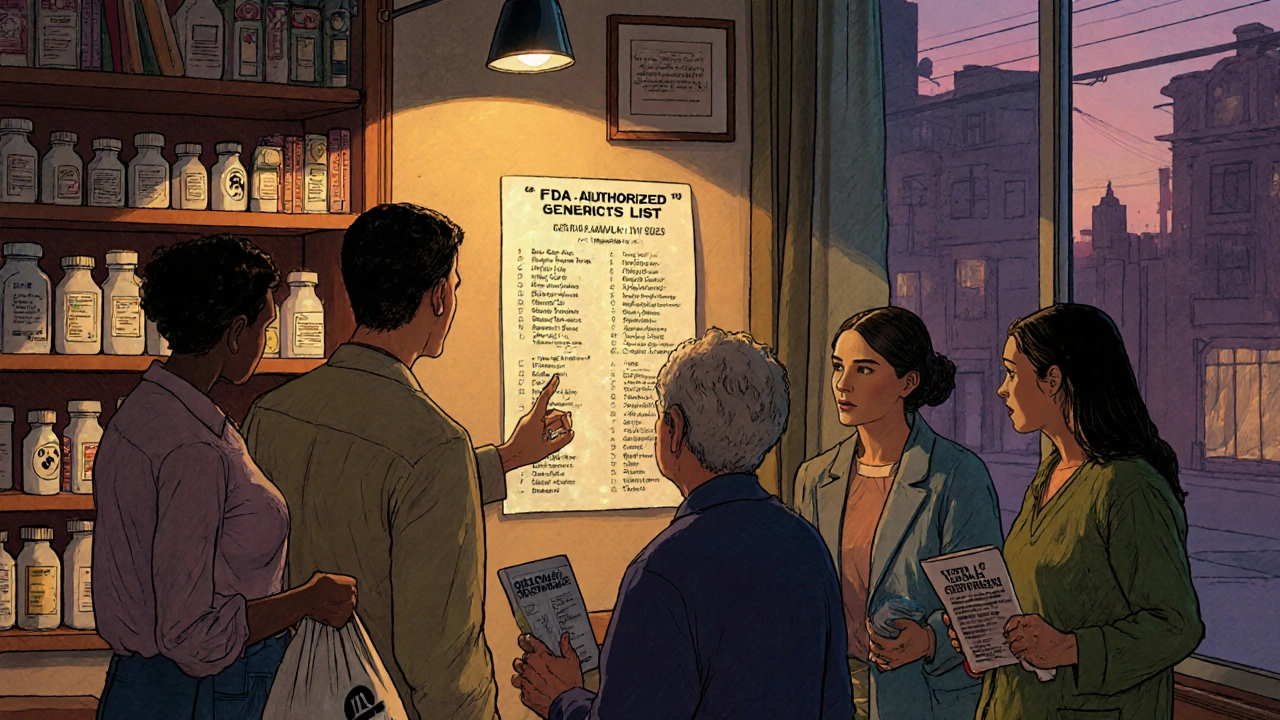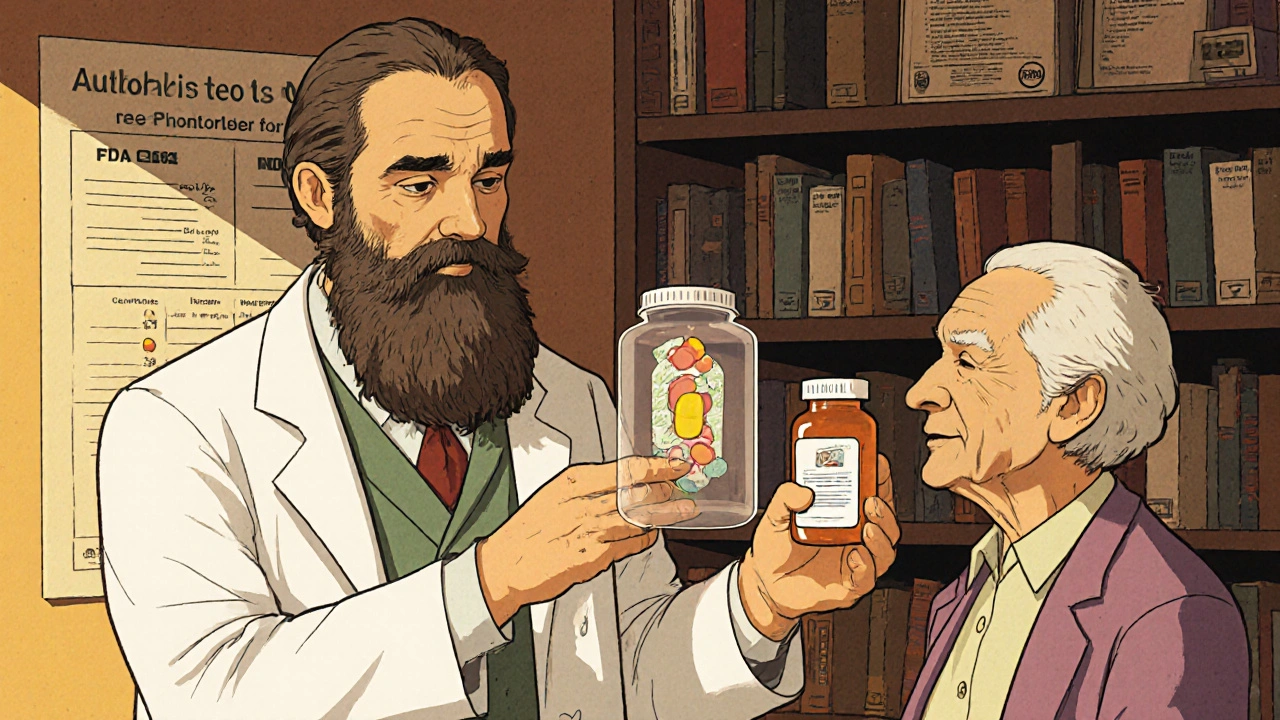When a patient walks into the pharmacy with a prescription for a brand-name drug, the pharmacist’s job isn’t just to fill it. It’s to make sure the patient gets the right medication at the right price-without compromising safety or effectiveness. One tool many pharmacists overlook is the authorized generic. It’s not just another generic. It’s the exact same pill as the brand, made by the same company, but sold without the brand name. And in certain situations, it’s the best option-sometimes the only safe one.
What Exactly Is an Authorized Generic?
An authorized generic is the brand-name drug, produced by the original manufacturer or under their direct license, but packaged and sold without the brand name. It has the same active ingredients, the same inactive ingredients-same fillers, same coatings, same everything. The only differences? The label, the color, maybe the shape. Inside? Identical.
This isn’t the same as a regular generic. Regular generics must prove they’re bioequivalent to the brand, but they can-and often do-use different inactive ingredients. For someone with celiac disease, a gluten-containing filler in a generic could trigger symptoms. For someone avoiding animal products, gelatin capsules in a generic might be a dealbreaker. An authorized generic doesn’t have those surprises.
The FDA requires manufacturers to list all authorized generics quarterly. As of September 2023, there were 257 authorized generics on the list-about 5% of all brand-name drugs with generic alternatives. Most are tablets or capsules, and they often show up after the first regular generic hits the market, giving patients more choices when cost becomes a concern.
When Should You Recommend an Authorized Generic?
Not every patient needs one. But for some, it’s the only way to avoid a bad reaction or a drop in effectiveness. Here are the top three situations where pharmacists should proactively suggest an authorized generic.
1. Patients With Allergies or Dietary Restrictions
Regular generics sometimes use fillers or dyes that the brand-name version doesn’t. A patient who’s been on a brand-name drug for years and has no issues might suddenly develop a rash or stomach upset after switching to a generic. Why? The new pill might contain lactose, gluten, or gelatin-ingredients the brand avoided.
For patients with celiac disease, strict vegan diets, or severe allergies to dyes like FD&C Red No. 40, an authorized generic is the safest substitute. It’s the same formulation they already tolerated. No guesswork. No risk.
2. Narrow Therapeutic Index (NTI) Drugs
Some medications have a razor-thin margin between working and causing harm. Warfarin, levothyroxine, phenytoin, and lithium fall into this category. A tiny change in blood levels-maybe from a different inactive ingredient affecting absorption-can lead to dangerous side effects or treatment failure.
Studies show 3-5% of patients on NTI drugs experience problems after switching from brand to regular generic. The FDA tracks this through therapeutic equivalence ratings, and even though authorized generics aren’t listed separately in the Orange Book, they’re automatically considered equivalent because they’re chemically identical. For these high-risk drugs, skipping the regular generic and going straight to the authorized version can prevent hospitalizations.
3. When the Patient Reports Reduced Effectiveness or New Side Effects
Let’s say a patient has been on a brand-name drug for years. They feel fine. Then they switch to a generic-and suddenly they’re dizzy, nauseous, or their condition isn’t controlled anymore. A 2021 survey of 1,200 community pharmacists found that 12% of patients reported this kind of change after a generic substitution.
Before assuming non-adherence or a new medical issue, check if an authorized generic is available. It’s often the missing piece. The patient didn’t stop taking their medicine. They just got a different version. Switching back to the authorized generic-same formula, no brand name-can restore stability without raising the cost.
How to Spot an Authorized Generic
You can’t tell by looking at the pill. But you can find out by checking the National Drug Code (NDC). Authorized generics share the same active ingredient and strength as the brand, but the labeler code will match the brand manufacturer (like Pfizer or Merck) or an authorized distributor (like Prasco or Greenstone), not a typical generic company.
The FDA updates its list of authorized generics every three months. It’s free, public, and searchable online. Pharmacists should bookmark it. Many wholesalers also carry these products, but distribution can be uneven. For example, Prasco’s authorized generics are widely available through AmerisourceBergen and Cardinal Health, but not McKesson. It pays to know your suppliers.

Insurance and Cost: The Hidden Catch
Authorized generics often cost 20-80% less than the brand-name drug. That’s a huge saving. But here’s the problem: many pharmacy benefit managers (PBMs) treat them as brand-name drugs for billing purposes.
A 2022 study found that 63% of PBMs put authorized generics in the brand-tier formulary. That means patients might pay a higher copay than they would for a regular generic-even though the medication inside is identical. Always check the patient’s plan before recommending one. Sometimes, the authorized generic is cheaper. Sometimes, it’s not. Don’t assume.
Also, some insurance plans don’t cover authorized generics at all unless the prescriber writes “dispense as written.” That’s why communication with the prescriber matters.
What to Tell the Patient
Patients get confused when their pill changes color or shape. A 2022 study found that 27% of patients stopped taking their medication after an unexpected appearance change. Only 8% did so when the change was properly explained.
Don’t just hand over the bottle. Say this:
- “This is the same medicine you were taking, just without the brand name.”
- “The inside of the pill is exactly the same-same active ingredients, same fillers, same everything.”
- “It’s cheaper, so you’ll save money, but it’s not a different drug.”
- “If you’ve ever had a reaction to your old pill, this one won’t cause the same issue because it’s identical.”
For patients with chronic conditions, this conversation can mean the difference between adherence and abandonment.

Legal and Documentation Notes
In 42 U.S. states, pharmacists can substitute a brand-name drug with an authorized generic unless the prescriber says “do not substitute.” That’s the same rule that applies to regular generics. But 18 states require you to notify the prescriber anytime you make a substitution-including authorized generics.
Always check your state’s pharmacy board rules. Document the substitution in your system using the correct modifier code (usually “DA” for drug substitution). Keep records showing the therapeutic equivalence. If there’s ever an audit or a question, you’ll be covered.
What’s Changing in 2025?
The number of authorized generics has grown by 18% per year since 2010. More are coming. Consumer awareness is rising too-GoodRx reports a 47% increase in searches for “authorized generics” between 2021 and 2022.
Legislation like the Affordable Insulin Now Act of 2023 could open the door for more authorized generics for high-cost drugs. The American Pharmacists Association is also updating its guidelines for 2024, with clearer recommendations for when to recommend them.
As value-based care becomes the norm, pharmacists who use authorized generics strategically will be seen as key players in reducing costs without sacrificing outcomes. It’s not about cutting corners. It’s about matching the right tool to the right patient.
Final Thoughts
Authorized generics aren’t magic. They’re not always cheaper. They’re not always available. But when they are, and when the patient fits one of those three key scenarios-dietary restrictions, NTI drugs, or unexplained side effects-they’re the best option on the shelf.
Don’t wait for the patient to ask. Be the pharmacist who checks. Be the one who says, “I see you’re on X. There’s an authorized generic available. Let me see if it’s right for you.”
It’s not just a cost-saving trick. It’s better care.


Write a comment